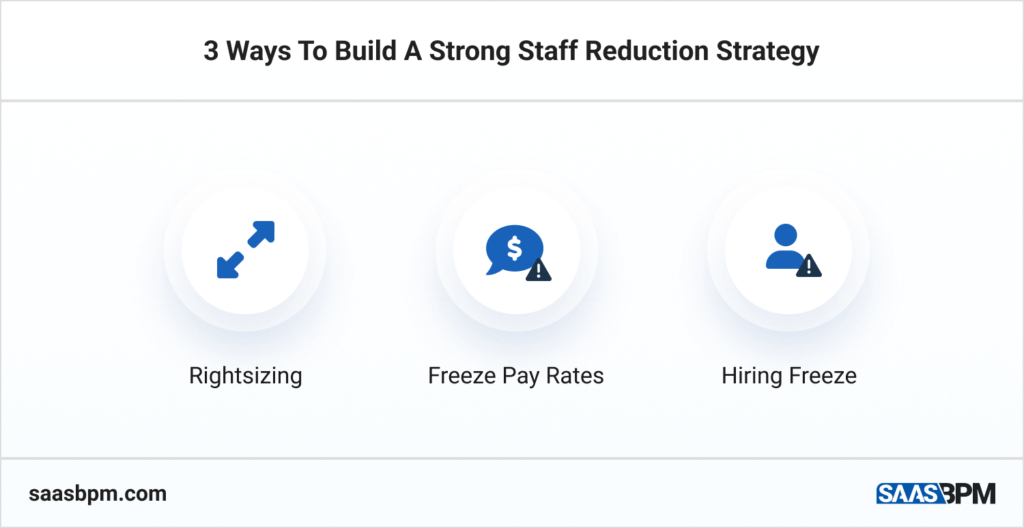Staff reduction is a measure that employers usually take when they absolutely have to. It leaves a bitter feeling in the team. As a result, there is always regret that maybe there was another alternative. However, there are times when job cuts are the only way to reduce costs and keep the business going. It is important to take a strategic approach to optimize your workforce. Also, build long-term processes in place to avoid drastic changes.
In the past couple of years of the pandemic, many companies had to make certain roles redundant as they were no longer relevant to the remote work scenario. Other employers have resorted to other short-term decisions. Examples are placing staff on furlough, reverting to retainers instead of full-time salaries, retraining etc.
However, building a solid staff reduction strategy for the long run as opposed to short-lived solutions is preferable in times economic transformations. In this article, we will explore when staff reduction is necessary, and top ways to handle it to the best advantage of your organization.
Staff Reduction: When and Why?
Staff reduction is often the solution when a company goes through a difficult time and needs to cut costs, or it goes through restructuring. However, this is not necessarily true. If a role is not critical to the job getting done, or if the employee does not perform well enough, this usually calls for a lay-off and replacement. Other reasons for staff reduction may be relocation, going out of business, outsourcing, introducing business tech, reducing operations or changes in role requirements.

However, routine lay-offs can intervene with employee engagement and company profitability. Therefore, it needs to happen with caution. Letting an employee go may seem like a minor change, but it can have a tremendous effect on the rest of the team, especially if the company is based on collaboration. Team members have to pick up the slack of the employee that left. This may bring about a decrease in productivity and motivation.
On the other hand, staff reduction could be a powerful tool for the success of your business. Apart from the obvious benefits like cutting down on costs and maximizing efficiency of resources, headcount reduction can also lead to increasing initiative, teamwork and morale in your organization, if handled properly.
3 Ways To Build A Strong Staff Reduction Strategy
Reducing the size of your workforce is never easy. After all, you need to pick from employees you’ve recruited for your company because they had talent and seemed like a good fit. However, if you are consistent with your organizational practices and aim for long-term staff reduction solutions, you will manage to sustain team productivity and success. Here are some top ways to do staff reduction in a gradual, optimized way:

Rightsizing
Rightsizing is a term that describes strategically transforming the size of your workforce according to the resources you have and targets you need to meet. In other words, it’s about keeping just as many employees as you need to keep the ball rolling. Rightsizing is not only about the number of staff members needed in your team, but also about the right skills to get the job done.
Mind you, rightsizing should not be confused with downsizing. The latter is about permanently reducing manpower without decreasing the workload. On the contrary, rightsizing is an ongoing process of tailoring the team size to the workload.

In addition, rightsizing is not an approach to fix problems like cost reduction quickly. Rather, it is a gradual, ongoing process that involves constantly monitoring performance of team members. The easiest way to do so is with a BPM software for HR managers. This solution gives you visibility into all roles within the company and each employee’s report of met and missed deadlines.
Freeze Pay Rates
Another strategy for handling staff reduction before it is critical is to freeze salaries and benefits. Your top performers may not support your decision. However, if you explain the current situation, they would be more likely to stay. Bear in mind that team members who are less experienced in the role or just do not invest enough effort may lose motivation to improve.

In order to avoid negative results, make a promise to review this matter on a regular basis and give updates on changes. Keep the discussion about pay, perks and work hours open. This way, you will make sure you have a realistic look at how your decision affects your workforce. In addition, you can spot opportunities to help pro-active staff members grow within the company.
There are different ways to make up for a pay freeze and still reward good, dedicated employees. These include work-life initiatives, incentive schemes, recognition perks. Examples are a personal parking spot, access to career development resources, branded gifts etc. as well as inclusion in company discussions.
Hiring Freeze
Hiring freeze is a quick way to reduce staff in your company. Basically, it refers to a halt in recruitment for non-essential positions. In the current pandemic situation most companies work remotely. Hence, roles around operations, research, development and events have become less necessary. However, you can continue hiring for positions that require specific skills and will generate profit from the very start.
This method has its benefits. First, a hiring freeze doesn’t evoke so much negativity as layoffs and furloughs. Second, this staff reduction strategy doesn’t hurt your employer brand in a way that other harsh methods do.
Staff reduction via hiring freeze is a better alternative to redundancies and furloughs as it is a long-term strategy. Of course, it needs reviews and updates from time to time. However, if you implement it well into your organizational policy, you can avoid anxiety and rumors within your team.

In addition, hiring freeze calls for a reassessment of recruitment practices and looking for other ways to complete all projects with the team available. Work with the people you already have and who are familiar with the company core values and culture. Think of how you can combine different roles and delegate tasks accordingly. This way, everyone is up-to-date with what the required results are.
To Recap
Staff reduction is not an easy decision to make. However, if you build a strong strategy that strives for long-term positive results, you can actually use it to motivate your team and boost productivity. Make sure all your recruitment decisions are necessary and applicable in a remote work setting.

